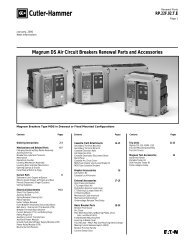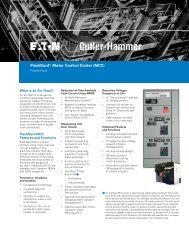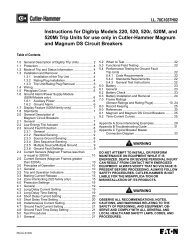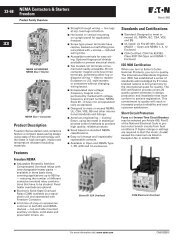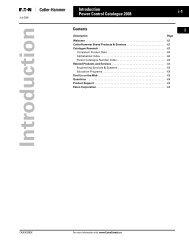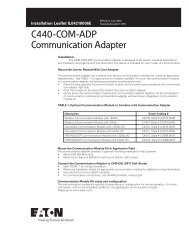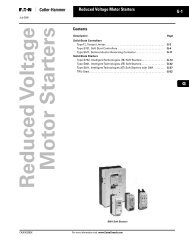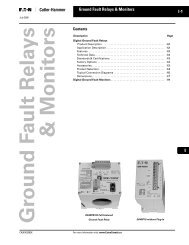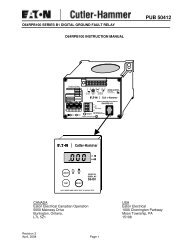M-Maxâ„¢ Series Adjustable Frequency Drive - Eaton Corporation
M-Maxâ„¢ Series Adjustable Frequency Drive - Eaton Corporation
M-Maxâ„¢ Series Adjustable Frequency Drive - Eaton Corporation
Create successful ePaper yourself
Turn your PDF publications into a flip-book with our unique Google optimized e-Paper software.
PID Controller, Actual Value Message FBV<br />
%<br />
P9.15<br />
P9.16<br />
FWD<br />
FBV<br />
1<br />
2<br />
Item<br />
Number Description<br />
1 Output frequency (Hz)<br />
2 Actual value (process variable PV)<br />
FWD: Start signal, clockwise rotating field.<br />
FBV: Actual value message, limit values exceeded (P9.15, P9.16).<br />
The upper and lower actual value limits (P9.15, P9.16) are<br />
“process messages”. They cannot be used for monitoring<br />
the actual value signal. FBV is not a fault message.<br />
When P5.1 (2.3) = 25, you can set the digital output or a<br />
signalling relay for the FBV.<br />
The FBV actual value message enables the M-Max PID<br />
controller to implement a direct “two-stage control”, as is<br />
commonly used for HVAC applications.<br />
Example: Ventilation system with two fans (frequency<br />
inverter). Under normal operating conditions, the<br />
maximum output power of fan 1 (M1) is sufficient<br />
to maintain the actual value (PV) at the reference<br />
value. When fan 1 is fully used and additional<br />
airflow is required, a second fan (M2) with<br />
constant power is a simple solution.<br />
t<br />
Parameters<br />
Block Diagram, Ventilation with “Two-Stage Control”<br />
FWD<br />
PV<br />
FBV<br />
Start<br />
1<br />
2<br />
Item<br />
Number Description<br />
1 <strong>Frequency</strong> inverter with PID controller for M1 fan motor<br />
2 Motor starter (frequency inverter, soft starter, contactor) for<br />
M2 fan motor<br />
FWD: Start signal drive 1.<br />
FBV: Actual value message of drive 1 for activating drive 2.<br />
Start: Start signal, drive 2.<br />
With the closed-loop control example shown here, the<br />
sequence is based on the signal diagram in the figure on this<br />
page. The process variables in the limit values are shown in<br />
percent (%). The output frequency (Hz) is shown<br />
superimposed in the same diagram.<br />
● Start of fan motor M1 with FWD signal. The actual value<br />
(PV) is below the limit value of P9.16. The FBV output<br />
(P5.1 [23 = 25]) then switches and fan motor M2 (Start)<br />
starts automatically<br />
● The actual value rises and reaches the upper limit (P9.15).<br />
The FBV output is automatically switched off (= fan M2<br />
Off). Fan M1 remains in operation and works in linear<br />
control mode. In a correctly set up system, this is the<br />
normal operating range<br />
● If the actual value drops below the limit value (P9.16), the<br />
FBV output is switched. and fan M2 is activated again to<br />
support fan M1<br />
● When the FWD signal is removed from frequency<br />
inverter 1, the inverter goes from RUN to STOP mode and<br />
decelerates the drive over the set ramp time<br />
● When frequency inverter 1 is stopped, the FBV output is<br />
automatically de-energized so that fan M2 also stops<br />
M-Max <strong>Series</strong> <strong>Adjustable</strong> <strong>Frequency</strong> <strong>Drive</strong> MN04020003E—April 2011 www.eaton.com 97<br />
M1<br />
M2<br />
0–10V/ 4–20 mA




